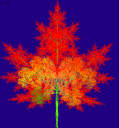Don’t Simplify- Present Compressible Complexity!
 There is an art to simplification. In the ideal case to simplify X you:
There is an art to simplification. In the ideal case to simplify X you:
1. Compress X without loss of information
2. Render X so that it can be experienced with a lower cognitive load or greater mental stimulation.
In my leadership class at Northwestern students practice simplification all quarter by taking a draft deliverable that is 7-15 pages of rich ideas and data and rendering it as single page document that meets the criteria above. To get a good result they must find deep patterns – semantic, graphic, temporal, etc. in the content and use that to compress the complexity of their deliverable.
It is interesting to note that the best results are not just easier to understand they are striking (mental stimulating), a bit like a work of art. Indeed, works of art may generate an aesthetic experience in part because they present sensory complexity that is easy for our brain to compress. For example, BMC Research Notes recently published, Musical Beauty and Information Compression. The key idea:
“Deep cognitive insights are reported as intrinsically satisfying, implying that at some point in evolution, the practice of successful information compression became linked to the physiological reward system. I hypothesise that the establishment of this “compression and pleasure” connection paved the way for musical appreciation…”
The experiments done found that random noise, rock music and Beethoven’s 3rd symphony compress to 86%, 60% and 40% of their original information content respectively. This implies that musical masterpieces present compressible complexity. I have seen similar studies about the visual arts.
Perhaps the key to the high art of simplification is not to simplify at all but instead to express complexity in a compressible form.